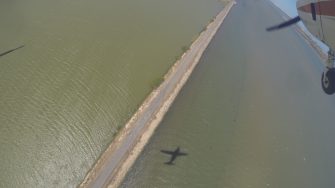
Date: Friday, November 2, 2018
Project: Eastern Australian Waterbird Survey
Observer: Richard Kingsford
For our full day on the Coorong and the Lower Lakes today, we had a full plane, stacked with eight people, including our pilot. We had five trainees which was great, three from the South Australian, one from NSW and one from Queensland governments. This is one of the great advantages of the larger plane which does everything the Cessna 206 can do and much better and more comfortable. It also rides the rough days better. The day didn’t have a great start. A line of thunderstorms, which woke as at 2am, was still rolling in and greeted us when we reached the airstrip at Goolwa in the morning. So we had to wait for about an hour until they had rolled through.
6am and ready for an early start but not with lightening in the background
Coming in over the ocean to start our survey down part the Murray Mouth out to sea.
The Coorong was humming with waterbirds. There were tens of thousands of grey teal, mountain duck and whiskered terns. Given how dry it was in the rest of eastern Australia, I was expecting thousands of banded stilts but there were less than a hundred. There were also thousands of migratory shorebirds, although perhaps not as many as we have counted in previous years. It is always difficult to remember through the years, without having the data point for comparison. We won’t really know until nearly the end of the year when we have crunched the numbers. The flying conditions deteriorated as we flew during the morning and the wind picked up from the west.
Beautiful colours played out, with the reflection of the sky in the salty water of the Coorong.
Heading south down the more than a 120km of the Coorong.
We completed our two counts on the Coorong later than usual, delayed by our late start by the weather. There was also more shoreline in the Coorong than in the past, indicative of shallower water levels. This meant more ‘islands’ were exposed and the waterbirds tend to use these shallow water areas for feeding which mean a lot of circling around the edges in our plane. There was a usual pelican colony going on the south Coorong of a few thousand birds.
Pelican colony on the South Coorong
After lunch, we headed out for our second count of the two lakes, Lake Alexandrina and Lake Albert. First we flew the western side of Lake Alexandrina, which meant flying down past the barrages. Large flocks of cormorants and pelicans roost on these platforms and fish where the water flows out to the Coorong. Today, there was also a seal cavorting on its back.
Surveying Lake Alexandrina (left), separated from the Coorong (right) by the wall called the barrages.
Not far from the barrages, there was an inlet where there are often colonies of waterbirds breeding. One of these was a straw-necked ibis colony of a few hundred nests, while the other was a large pied cormorant colony of thousands of breeding birds, mixed in with some breeding straw-necked ibis. It was a spectacular site.
The large pied cormorant colony on Lake Alexandrina
We then flew around until we got to the opening to Lake Albert and headed on the ‘grand tour’ around this great lake. Lots of cormorants, ibis, pelicans, swans and black duck. There was also a straw-necked ibis colony of a few hundred birds. The water levels seemed to be quite high on the two lakes. My impression before we got here was that we would be seeing many more waterbirds here than we have actually surveyed because everywhere else is so dry. Certainly numbers will be up on the Coorong from previous years but I am not so sure for the two lakes.
Large flocks of great cormorants, pied cormorants and pelicans roost on the spits of Lake Alexandrina
Surveying Lake Alexandrina in a 30knot westerly was not fun, with the whitecaps showing how rough it was on the lake.
We finished by late afternoon, tired of the buffeting we had endured through the day with the blustery wind but still great to see these lakes and their waterbirds.
